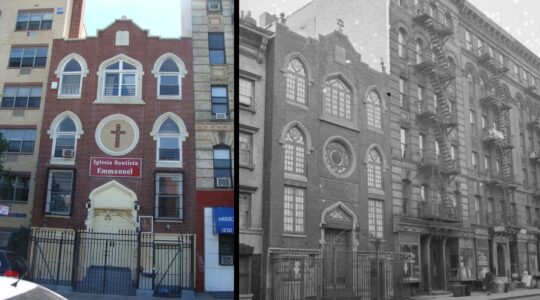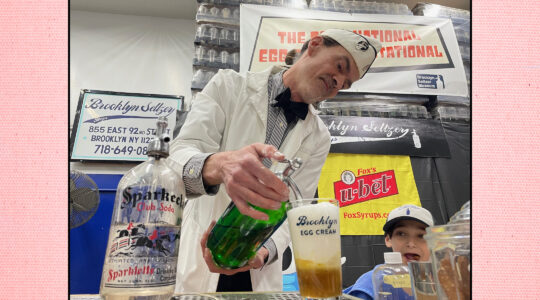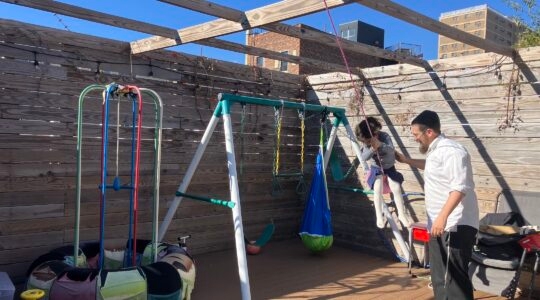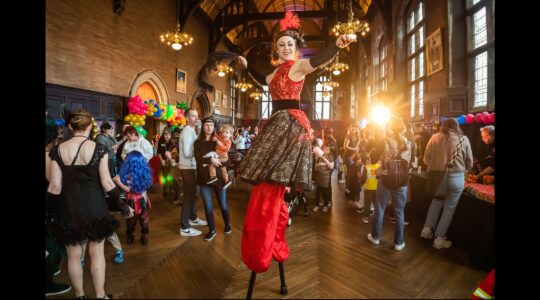Ever since they were young children, Elan and her brother, Jonathan, were driven weekly by their mother, Marilyn Ontell, from their home in Manhattan to that of their grandmother, Annette Ontell, in Hillside, N.J.
“Some people go to church every Sunday,” said Jonathan. “We went to Grandma’s house every Sunday for 30 years.”
When Ontell died of pneumonia in 2011 at the age of 93, her grandchildren decided to create a documentary on what they called “the extraordinary life of an ordinary woman,” including her work as a dress designer and the massive amount of possessions she left behind. Jonathan is now an artist Elan, a filmmaker who had trained her camera onto her beloved grandma. The brother-and-sister team spent 10 years interviewing Ontell and recording the cluttered collections that overflowed her cape-style home at 306 Hollywood Ave.
The documentary, “306 Hollywood,” opens at the Quad Cinema at the end of the month.
Ontell was born in 1918 at what was then Newark Beth Israel Hospital, and lived in the city’s Jewish community until she and her husband, Herman, moved to Hollywood Avenue in Hillside in 1944. Many of the material items she amassed in the years that followed stayed in the house, as well.
“Clutter. I’ve never gotten rid of clutter,” said Ontell in one of many interviews included in the one-hour, 34-minute film.
“What do they call a type of person who has all that crap?” she asked her granddaughter. “A rat trap?”
“A pack rat,” Elan answered.
“I’m a pack rat,” her grandmother said with visible glee.
After Ontell died, her grandchildren turned the house into “an archeological dig,” according to Jonathan. They discovered mountains of possessions she had been hoarding for years, including a multicolored array of toothbrushes, old radios and cameras and four decades’ worth of copies of the New Jersey Jewish News (NJJN).
“She was an avid reader until the end of her life,” Elan told NJJN. “Much of her pack ratting was your periodical. They were everywhere, and she would have people’s birthdays cut out of it and articles she loved. It was all around us.”
When they asked her to define her culture and religion, Ontell told her grandchildren, “first of all, my culture is being a mensch.”
“She was not a religious person,” Jonathan said. “Her ancestry was secular Judaism dating back to her Russian and Polish ancestors, and her identity was very intensely Jewish.”
The filmmakers call their approach to documenting their grandmother “magical realism.” It combines the mundane elements of an old woman’s life with what Elan called “the language of mythology and fairy tales to talk about the big transition of losing someone you love.”
Said Jonathan, “We wanted to find fun and engaging and creative language to talk about our grandmother, and we wanted to bring in other points of view with experts who deal with death from various aspects.”
To better understand Ontell’s life and cope with her death, they interviewed a funeral director, archeologist, physicist and fashion conservator.
In a sense, Sherry Vered Anthony, a funeral home director at the Riverside Memorial Chapel in New York, guided them in structuring part of the narrative. Anthony said in the film that, according to Jewish lore, the soul “continues in a place on earth that is most familiar and comforting and that is its home. It remains in its home for 11 months. You have those 11 months to make your grandmother tangible again because your grandmother is still here.”
Physicist Alan Lightman, a professor of humanities at the Massachusetts Institute of Technology, presented a very different point of view, saying on camera that “everything is atoms and molecules and nothing more.” After death, there are “atoms floating around space that are your grandmother, but they are not in the arrangement that was your grandmother.”
During her life, Ontell collaborated fully with her grandchildren’s project. In one of the film’s most engaging scenes, Ontell attempts to model dresses she had designed years earlier, even though the outfits had become embarrassingly too small for her to wear. While struggling to make the costume changes, she sits in her underwear and speaks to the camera.
“I used to weigh 95 pounds. I am twice the size of what I was. I feel like a clump. A clump of nothing. A clump of flesh,” she said.
“Why?” asks Elan.
“I don’t move easily, I don’t walk too well. It’s difficult. I used to run to the buses and to the trains.”
Elan said that the scene made the final cut for the following reason: “She was uncomfortable, but our main character is not a traditional heroine. She is what you would call a ‘little old lady.’ It was a bare-your-soul approach to ‘here is what mortality looks like.’”
“Clothing is the fastest track to understanding people,” said Nicole Bloomfield, a conservation technologist at The Museum at Fashion Institute of Technology (FIT) in New York, as she pointed out small tears and stains in the dresses Ontell had designed. As Bloomfield pored over the clothes, she said she “really felt transported to another space and another moment” in an earlier portion of Ontell’s life.
At another point in the film, seven years before the end of her life, Elan asks her grandmother if she fears dying.
“Oh, no, never,” responds Ontell. “At 86 years of age I think I’m very fortunate I’ve lived so long. Sometimes I think it would be a relief because it is getting difficult taking care of the medication being alone.”
Asked how Ontell would react to seeing the documentary, which the siblings completed a week before its world premiere at the Sundance Film Festival in January, Jonathan told NJJN, “she would get a kick out of it because we did it and she would see the creativity. But she was a modest person and she might have thought, ‘Oh, you’re making such a fuss over me.’”
Another time Elan asks Ontell, “If you were to create a short summary of your life, how would you do it?”
“It has been a success,” she answered. “I achieved having a good credit line. I paid my bills on time. I have a good reputation.
“306 Hollywood” opens Sept. 28 at the Quad Cinema, 34 W. 13th St., quadcinema.com. For more information, visit “306 Hollywood”’s pages on Instagram and Facebook.
The New York Jewish Week brings you the stories behind the headlines, keeping you connected to Jewish life in New York. Help sustain the reporting you trust by donating today.




